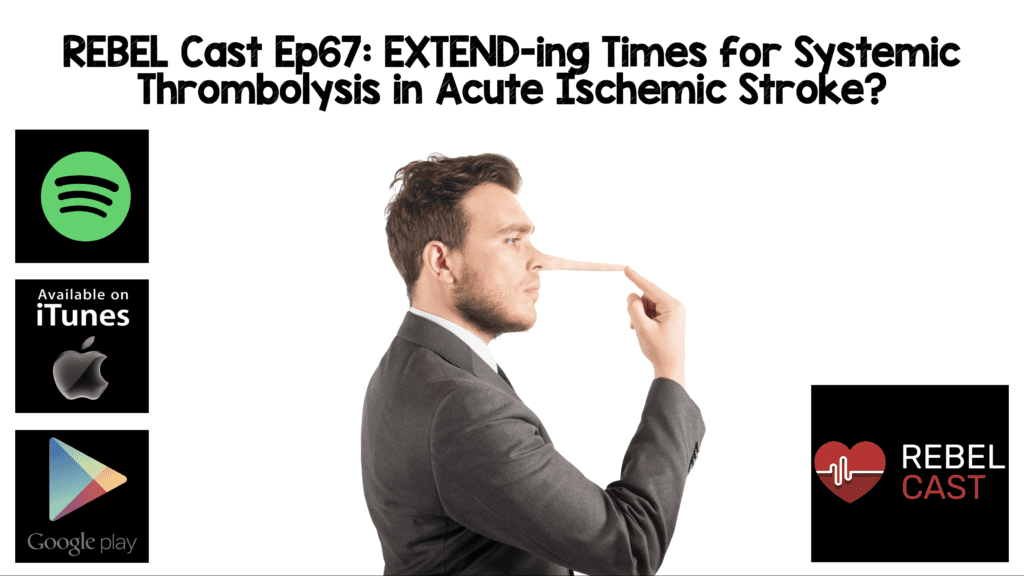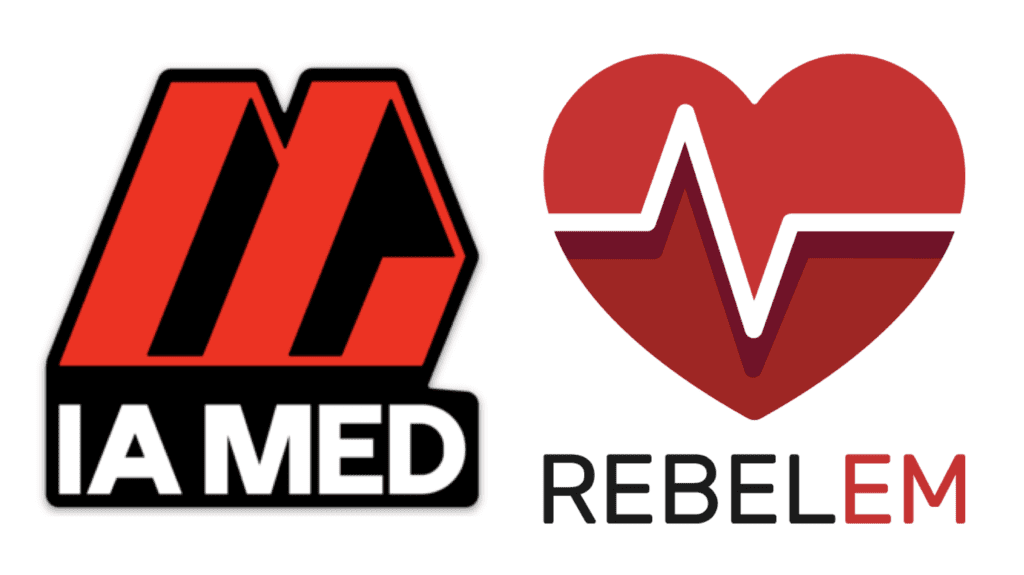
 Background: Despite the lack of replication of the NINDS & ECASS-3 trials, guidelines recommend the use of tPA in the ≤4.5hr window after the onset of symptoms of acute ischemic stroke [2]. These recommendations used non-contrast computed tomography (NCHCT) for the selection of patients. More recent endovascular studies have shown that perfusion-based imaging can show potential viable brain tissue beyond the 4.5 hour mark in patients with large vessel occlusions and result in good neurologic outcomes. This advance has prompted investigators to look at perfusion-based technology to identify a larger cohort of patients without large vessel occlusion that may be candidates for systemic thrombolysis. One of the big fears in stroke management is the concept of indication creep: finding more uses for a medication or product without strong evidence to support its use. The bigger question is, does this increase in use help the company’s bottom line or the patient? It is no wonder physicians are skeptical of industry sponsored trials, as we sometimes question the motives behind the study. Now we have another industry sponsored trial: EXTEND. In this trial.
Background: Despite the lack of replication of the NINDS & ECASS-3 trials, guidelines recommend the use of tPA in the ≤4.5hr window after the onset of symptoms of acute ischemic stroke [2]. These recommendations used non-contrast computed tomography (NCHCT) for the selection of patients. More recent endovascular studies have shown that perfusion-based imaging can show potential viable brain tissue beyond the 4.5 hour mark in patients with large vessel occlusions and result in good neurologic outcomes. This advance has prompted investigators to look at perfusion-based technology to identify a larger cohort of patients without large vessel occlusion that may be candidates for systemic thrombolysis. One of the big fears in stroke management is the concept of indication creep: finding more uses for a medication or product without strong evidence to support its use. The bigger question is, does this increase in use help the company’s bottom line or the patient? It is no wonder physicians are skeptical of industry sponsored trials, as we sometimes question the motives behind the study. Now we have another industry sponsored trial: EXTEND. In this trial.
REBEL Cast Episode 67: EXTEND-ing Times for Systemic Thrombolysis in Acute Ischemic Stroke?
Click here for Direct Download of Podcast
What They Did:
- Phase 3, multicenter, randomized, placebo-controlled trial
- Patients with ischemic stroke with hypoperfused but salvageable regions of the brain on perfusion imaging in the 4.5 – 9.0 hr window after onset of stroke or on awakening with stroke (if within 9 hrs from the midpoint of sleep)
- Randomized to systemic tPA vs placebo
- Alteplase = 0.9mg/kg of body weight (maximum = 90mg) administered IV as a 10% bolus and 90% infusion over 1hr
Outcomes:
-
Primary: mRs of 0 or 1 at 90 days
- The risk ratio was later adjusted for age and clinical severity at baseline
-
Secondary:
- mRs score at 90days using an ordinal analysis to assess functional improvement
- mRs score of 0 – 2 at 90 days (functional independence)
- Percentage of reperfusion of at least 50% and of at least 90% at 24hrs after the intervention
-
Tertiary:
- Recanalization at 24hrs after stroke
- Major neurologic improvement (defined as a reduction in the NIHSS score of ≥8 points or a score of 0 or 1 within 24 hours, 72 hours, and 90 days after intervention)
-
Safety:
- Death within 90 days after intervention
- Symptomatic ICH (confluent blood clot occupying >30% of the infarct with substantial mass effect) within 36hrs after intervention with an increase of at least 4 points in the NIHSS score from baseline
Inclusion:
- ≥18 years of age
- Excellent functional status prior to enrollment (defined as a score of <2 on the modified Rankin scale)
- Had a stroke with a clinical severity score at presentation of 4 to 26 on the NIHSS
- Had hypoperfused but salvageable regions of brain detected on automated perfusion imaging
- Defined as an estimated volume of irreversibly injured ischemic-core tissue of <30%)
- Perfusion lesion-ischemic core mismatch was defined as a ration >1.2 between the volume of hypoperfusion and the volume of the ischemic core, an absolute difference in volume greater than 10mL, and an ischemic core volume of less than 70mL
- Occlusion of a large cerebral vessel was not a prerequisite for inclusion
Exclusion:
- Patients considered for endovascular thrombectomy at the time of enrollment
- Rapidly improving symptoms, in the judgment of the managing clinician
- Eligible for Endovascular Clot Retrieval
- Pre-Stroke mRs of ≥2
- Contraindication to contrast agents
- Ischemic core >1/3 MCA territory
- Pregnancy
- Previous stroke within last 3 months
- Recent history or clinical presentation of ICH, SAH, AVM, Aneurysm, or Cerebral neoplasm
- Use of oral anticoagulation and INR >1.7
- Clinically significant hypoglycemia
- Uncontrolled HTN (SBP >185mmHg or DBP >110mmHg) on at least 2 separate occasions at least 10 minutes appart or requiring aggressive treatment to reduce BP
- Major surgery within the preceding 14 days
- Thrombolysis within previous 72hrs
Results:
- Original sample size was supposed to be 400 patients
- Later sample size modified to 310 patients
- Only 225 of planned 310 patients enrolled due to early stoppage
- 25% of patients received assigned intervention in >6.0 – 9.0hr window
- 10% of patients received assigned intervention in the >4.5 – 6.0hr window
- 65% of patients woke up with their stroke symptoms with an unknown time of onset
- Initial NIHSS Score at Enrollment:
- tPA: 12 (Range 8.0 – 17.0)
- Placebo: 10 (6.0 – 16.5)
- Primary Outcome of mRs of 0 or 1 at 90d:
- tPA: 35.4%
- Placebo: 29.5%
- aRR 1.44; 95% CI 1.01 – 2.06; p = 0.04
- The unadjusted risk ratio did NOT show a significant difference between groups (RR 1.2; 95% CI 0.82 – 1.76; p = 0.35)
- Symptomatic ICH:
- tPA: 6.2%
- Placebo: 0.9%
- aRR 7.22; 95% CI 0.97 – 53.5; p = 0.05
- No improvement in functional status or functional independence at 90days
- No statistical difference in mortality within 90 days after intervention (11.5% with tPa vs 8.9% with placebo)
Strengths:
- Randomization was performed through a centralized website with stratification according to geographic region and time of intervention (>4.5 – 6.0hrs & 6.0hrs – 9.0hrs after stroke onset), or on awakening with stroke symptoms
- Symptomatic ICH was adjudicated by a central panel of stroke neurologists and neuroradiologists
Limitations:
- Trial terminated early because of a loss of equipoise after the publication of positive results from the WAKE UP trial published in May 2018. This is a methodological issue, as most trials that go to completion have a regression to the mean, meaning trials stopped early, tend to be hyperinflated in their results.
- The design of the trial, the analysis and collection of the data were performed by members of the executive committee and by the investigators at trial sites who had multiple financial conflicts of interest, including Boehringer Ingelheim the manufacturer of alteplase, which again does not negate the results, but should cause one to be skeptical of the results.
- Unclear if patients were consecutively enrolled (i.e. a convenience sample)
- Advances in stroke care occurred during enrollment of this study, so it is difficult to know how that affected the study
- Few patients enrolled at each site hinting that this only applies to a small group of patients overall
Discussion:
- Recruitment for this trial occurred from 2010 through February 2018. Stroke management with endovascular therapy had changed quite a bit from 2010 to 2018. MR CLEAN, the 1st positive endovascular therapy study was published in January 2015.
- Trial required a sample size of 400 patients to provide a 80% power to detect a between-group difference of 15% in the primary outcome of mRs of 0 or 1 at 90 days.According to the authors after a blinded review, the sample size was revised to 310 patients, which again was not met after the trial was stopped early.
- The original pre-specified analysis of the primary outcome was supposed to be with the more standard logistic-regression model, however with no explanation the authors used a covariate-adjusted modified Poisson regression instead, which has not traditionally been used in previous stroke trials (Don’t stress about what each of these mean. Simply put regression modeling is used to adjust for confounding variables.) What is interesting is the original logistic regression modeling can be found in the supplementary appendix, which found no difference between groups, however the covariate-adjusted modified Poisson regression model which is what was published in the manuscript did find a small difference.
- Despite having 16 centers in Australia, 1 center in New Zealand, 10 centers in Taiwan, and 1 center in Finland, the authors were only able to recruit 225 patients from 2010 to 2018
Author Conclusion: “Among the patients in this trial who had ischemic stroke and salvageable brain tissue, the use of alteplase between 4.5 – 9.0 hours after stroke onset or at the time the patient awoke with stroke symptoms resulted in a higher percentage of patients with no or minor neurologic deficits than the use of placebo. There were more cases of symptomatic cerebral hemorrhage in the alteplase group than in the placebo group.”
Clinical Take Home Point: This study should in no way change practice and is a ridiculous display of statistical hocus pocus (i.e. multiple regressions ran, and the one that worked for the authors was the one selected for the manuscript). Another example of a small study, stopped early, with frank manipulation of data to help promote one thing…more money in the pockets of the company making the medication.
References:
- Ma H et al. Thrombolysis Guided by Perfusion Imaging up to 9 Hours after Onset of Stroke. NEJM 2019. [Epub Ahead of Print]
- Powers WJ et al. 2018 Guidelines for the Early Management of Patients with Acute Ischemic Stroke: A Guideline for Healthcare Professionals From the American Heart Association/American Stroke Association. Stroke 2018. PMID: 29367334
For More Thoughts on This Topic Checkout:
- EMLit of Note: EXTEND Alteplase Shenanigans
- EMNerd (EMCrit): The Case of the Magician’s Sleight
- REBEL EM: Extending the tPa Window to 4.5 – 9 Hours in Acute Ischemic Stroke (AIS)?
- Journal Feed: EXTEND – Alteplase Up to 9 Hours Out?
- The Bottom Line: EXTEND – Thrombolysis Guided by Perfusion Imaging up to 9 Hours After Onset of Stroke
- First10EM: Stroke Thrombolytics Update 1 – The WAKE UP Trial
-
First10EM: Stroke Thrombolytics Update 2 – The EXTEND Trial
Support the Show by Paying & Claiming 0.5hrs of CME/CEH by Clicking on the Logo Below
Post Peer Reviewed By: Anand Swaminathan, MD (Twitter: @EMSwami)
The post REBEL Cast Episode 67: EXTEND-ing Times for Systemic Thrombolysis in Acute Ischemic Stroke? appeared first on REBEL EM - Emergency Medicine Blog.


